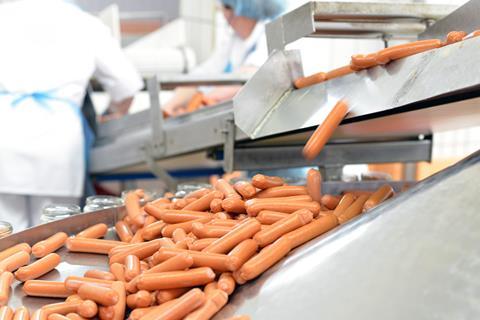Once known as a hospital superbug, Clostridioides difficile is now turning up in surprising places – production animal farms, soil, retail meats, vegetables, ready-to-eat salads, and even household kitchens. Recent research suggests this gut pathogen may not be confined to just hospital wards but is moving through our food chain, raising questions regarding how C. difficile finds its way to our plates, and what might be the result.
Here, we’ll trace the hidden journey of C. difficile from “farm to fork”, exploring the science behind its resilience and how genomic evidence links strains from hospital cases of C. difficile infection (CDI) to animals and food, with the aims of raising awareness to aid prevention and safeguard health across the food chain.
C. difficile is a spore-forming bacterium that causes serious gut infections. In the spore form, C. difficile can survive heat, drought, refrigeration, disinfectants, hand sanitisers, and antimicrobials. It can also remain dormant in the environment for years, making it difficult to eradicate.
C. difficile rose to prominence in the 1970s, with increasing reports of it causing antimicrobial-associated diarrhoea and severe colon inflammation in hospitalised patients. However, it has now spread beyond hospital walls — into community settings, animals, food, and the environment.
From farm to fork: following the trail
This story began like many stories of infection do, in places that seem far removed from the hospital or clinic. On a quiet animal farm, a newborn animal takes its first shaky steps. Within the first few hours of this baby animal’s life, C. difficile colonises its gut. Colonised animals, regardless of whether they are diseased or not, excrete spores in their faeces, scattered across soil, stalls, sheds, and boots. And from there, the journey begins.
On the farm
The hardy spores of C. difficile can often be found in the guts of livestock — including calves, cattle, piglets, pigs, and poultry. Neonatal animals are a major reservoir of C. difficile because their gut microbiota is not yet established, and there is no ability to confer resistance to colonisation. Colonised animals, often without disease, excrete spores in their faeces, which can persist in soil or spread throughout the farm environment. Studies in Portugal, Russia, and Australia have independently reported that farms have a predominant C. difficile strain found in animal faeces, as well as animal feed, soil collected near sheds, water from drinking bowls, and/or the intestines of common farm pests — showing circulation within a single farm. As animals age, C. difficile usually disappears as it gets outcompeted as the gut microbiota establishes. However, in modern intensive farming, where animals live close together and antimicrobials are used as treatment for or to prevent infections, C. difficile can flourish with no competition to keep it in check, due to the antimicrobial-disrupted gut microbiota. Hidden among the effluent and manure piles on such farms, C. difficile quietly survives, ready to hitch a ride wherever the farm produce goes next. This raises important questions about how farm management practices, antimicrobial use, and animal health intersect with human disease.

In the environment
To reveal the unseen network through which C. difficile moves beyond the farm and into the broader environment, one must “follow the faeces”. Once excreted, C. difficile spores can persist in soil and water — travelling with runoff, spreading onto crops via the use of effluent and manure as fertilisers, and settling into new habitats. Studies have isolated C. difficile in compost derived from animal manure, rivers, ponds, turf, public lawn, and even commercial potting mixes — all of which are sources for long-distance dispersal between farms and communities. For example, in some States of Australia, pig manure is used as fertiliser for growing turf, which is very popular in newly developed suburbs as it provides an instant “roll-out” lawn. Coincidentally, or not, the most common strain of C. difficile found in lawns in some parts of Australia, ribotype 014, is also the prevalent pig strain in the country, and also the most common strain isolated from human disease. This is a subtle but important reminder that pathogens don’t respect sector boundaries.
At the processing plant and in food
The food supply chain is a complex system, and C. difficile has found its way into it. Over the past decade, studies in North America, Europe, Asia, and Oceania have detected this gut bacterium on carcasses at abattoirs, meats, seafood, and vegetables. Its prevalence varies across food types and geographical regions, likely due to differences in hygiene and processing practices. In Europe, C. difficile was found in <3% of meat, but this figure can be as high as 12-20% in Canada and up to 42% in the USA. For seafood, C. difficile was detected in 5% of shellfish in the USA and 49% of mussels in Italy – not surprising really, mussels are filter feeders and if C. difficile is in the water, mussels will just concentrate it! Among vegetables, C. difficile prevalence ranges from 8% of ready-to-eat salads in Scotland to 50% of retail potatoes in Australia. While contamination levels are low, usually but not always, the finding of identical strains of C. difficile in humans, animals, and food hints at a potential foodborne risk.
In processing plants and slaughterhouses, carcasses, stainless steel surfaces, and cutting boards can harbour spores if cleaning isn’t meticulous. Cooking kills most bacteria, but C. difficile spores can survive 71°C, the recommended cooking temperature for ground meats, for at least 2 hours — surviving long enough to reach the dining table if hygiene is compromised. Spores can also survive in the presence of food preservatives commonly used in uncooked, ready-to-eat processed meats (such as salami and ham), as well as surviving the acidity and cooking of fermented pork sausages. For now, the actual risk of infection from food remains uncertain, yet the fact that C. difficile has been repeatedly detected along the food chain keeps researchers and the Food and Agriculture Organization (FAO) of the United Nations cautious, as shown in a recent FAO report.

On the table
On our dining table, contaminated ready-to-eat meats and salads can be eaten without further processing, and spores may still cling to raw meat or vegetables by the time they reach the kitchen. Cross-contamination during preparation can occur through knives, cutting boards, or hands. In fact, C. difficile has been isolated from households, including from pantries, fridges, cutting boards, and kitchen countertops.
The One Health connection
”The emerging story of C. difficile is a textbook example of what scientists call a One Health problem: a challenge that sits at the intersection of human, animal, and environmental health.”
When we find indistinguishable strains of C. difficile in animals, soil, food, or a patient’s stool sample, that’s not a coincidence. It’s a connection.
In the past, infection prevention and control focused almost entirely on hospitals. But as genetic tools like whole-genome sequencing have become widespread, the notion that CDI is just a hospital-acquired infection is challenged. When researchers compare C. difficile genomes from different sources — hospitals, farms, wastewater, food products — they often find startling similarities. Identical or near-identical strains appear in people who have never been hospitalised, in animals, and in food.
Numerous genomic studies comparing human and animal isolates have revealed striking similarities in support of interspecies transmission, but with no evidence that the two hosts ever encountered each other, suggesting that at least some community cases may be traced back to food or environmental exposure. In Europe and North America, genomic matches have been reported between C. difficile isolated from retail meats and human cases of community origin. In Australia, the same ribotype was found in humans, piglets, compost, lawn, river, garden, shoe soles, and potatoes. And genomic analysis further revealed clustering of indistinguishable human and pig strains, as well as the clustering of closely related human, compost, lawn, and potato strains in Australia. While these links don’t prove direct transmission through food, they strongly suggest a shared ecological source or reservoir with animals and food playing an important role in disease transmission.
Understanding this transmission network is the key to prevention. If C. difficile can persist in soil, survive processing, and reach the community through food or water, then control can’t stop at the hospital door. Surveillance needs to extend to the environments where the bacterium thrives (or perhaps survives) unseen — farms, wastewater plants, compost, and even in high-risk food. That’s where the One Health approach makes a difference. It brings veterinarians, microbiologists, ecologists, and public health experts together to map these hidden pathways. Instead of managing the infections after they’ve happened, we can aim to determine their origins, identify crossover points, and intervene earlier to prevent infections from occurring in the first place. We need to understand how these microbes move so we can make smarter decisions — in farming, in food handling, and in healthcare.

Current research and knowledge gaps
Despite growing knowledge of C. difficile outside hospitals, much of this journey through food and the environment remains a mystery. Scientists are only beginning to use genomic epidemiology to map how it moves between animals, soil, food, and humans. The picture is far from complete. Detecting C. difficile spores in food or soil doesn’t automatically mean they cause human disease. Many strains appear to circulate harmlessly, while others — often those carrying toxin genes — are more likely to cause illness.
Another major question is how often foodborne transmission occurs. Despite evidence of contamination in/on retail meats and vegetables, confirmed outbreaks linked to food remain rare. It’s likely that (i) C. difficile spores survive the journey but fail to germinate in healthy guts; (ii) infection requires additional risk factors (such as a disrupted gut flora, compromised immunity, or other comorbidities); or (iii) cases are being missed due to poor community surveillance.
Why it matters
At first glance, C. difficile might seem like a niche problem — a stubborn hospital bug that only threatens the very sick. But its growing presence beyond healthcare settings tells a bigger story about how our actions ripple through the microbial world. If C. difficile spores are circulating through farms, food, and the environment, the implications reach far beyond hospital infection prevention and control. It means that how we manage livestock, antimicrobials, and waste all influence the risk downstream.
For farmers, this problem highlights the value of responsible antimicrobial stewardship and improved waste management. For food producers, it reinforces the need for hygiene protocols that account for hardy spore-forming bacteria. And for public health, it underscores the importance of environmental monitoring — from wastewater plants to supermarket shelves — as early warning systems for emerging risks.
”The old mantra of “surveillance is the cornerstone of public health” is as relevant today as it was 50 years ago.”
There are economic stakes, too. Each case of disease caused by C. difficile adds to costs through treatment and lost productivity. In Australia, each hospitalised case costs our healthcare system over AUD$19,000, totalling around AUD$200 million annually. In the USA, the Centers for Disease Control and Prevention has estimated that CDI costs the healthcare system in that country over US$1 billion annually.

Turning awareness into action
Back on that quiet animal farm, the newborn from our opening scene is now a year older. Around it, millions of invisible microbes continue their silent exchanges between soil, animal, food, and water — among them is C. difficile.
For scientists, the challenge now is not just to trace the journey of C. difficile, but to act on what it reveals. Tackling this problem will require collaboration across disciplines — veterinarians, farmers, food safety experts, microbiologists, and clinicians. This may mean cleaner waste management on farms, smarter antimicrobial use in animals and humans, improved food hygiene protocols, and more targeted surveillance that spans hospitals, farms, general practitioners, and wastewater treatment plants. Each step adds a piece to the puzzle, turning awareness into prevention.
From the farmyard to the hospital ward, and every kitchen in between, C. difficile teaches us a simple truth: to stay healthy, we must think beyond ourselves as our health is interconnected with the health of animals and our shared environment.








No comments yet